How to Create a Strong B2B Social Media Presence in 2023
You’ve probably come across successful B2B companies on social channels, such as Semrush or Ahrefs. Their presence and strategies prove how important social media marketing is for long-term brand growth.
However, to watch others succeed on social media platforms is easier than to do it yourself, especially if you don’t know where to start.
Don’t worry, we’ve got you covered.
Today, we’re talking about B2B marketing on social media and how you can create a strong social media presence in 2023 while staying within your marketing budget.
Let’s dive right in.
Why are Social Media Platforms Important for a B2B Company?
It should go without saying that social media platforms and social media tools have become an integral part of modern business operations. Companies of all sizes and industries are leveraging these to:
- Reach and engage with their target audience
- Increase brand visibility and trust
- Drive business growth
This requires you to focus on several key factors in your social media strategy, which are nicely laid out in this infographic:
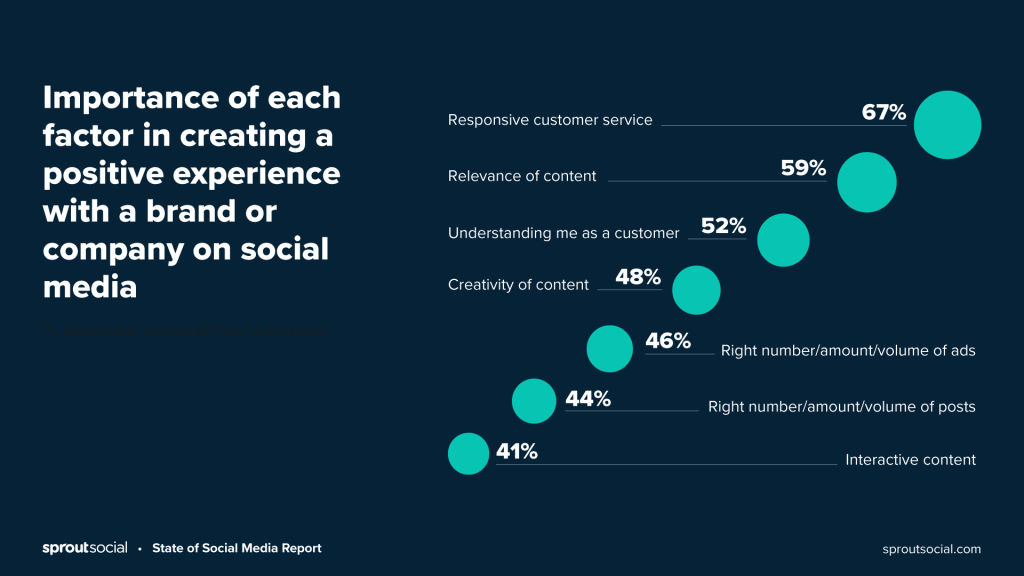
As you can see from the image above, good customer service, content quality and relevance, as well as personalization are the keys to creating a positive experience.
Additionally, by investing in relevant ads and a good posting frequency, you would already be on your way to achieve your key business objectives.
Achieving your objectives in the competitive B2B space can rely heavily on social media. This is why the importance of social media marketing cannot be overstated in this oversaturated sector.
But before we delve deeper into the best practices you should implement to build a strong presence on the best social media platforms for your business, let’s talk briefly about their importance.
1. They drive direct traffic to your website
Social media platforms can be a powerful source of direct traffic to your website and a valuable SEO tool.
Let us show you an example.
This website right here has direct (from resources including social networks) and social media channels among the top three sources of traffic, indicating that they’re doing quite well with a social media strategy:

So, driving traffic from social media is a great way to tell the search engines that your website has something truly valuable to offer. That’s why traffic from social media is one of those social media KPIs you should monitor at all times.
Your focus here is not only on publishing high-quality posts and content on your social networks. It should also be to use your social marketing efforts to inspire action among your followers.
Here’s how you can do it:
- Use a value-driven CTA with every post
- Give people something to click on
- Promote new products with engaging copy and a clear value proposition
- Give people a reason to click on your link
- Focus on clear and engaging messaging to go with every post
- Diversify the content you post to keep your audience engaged
But remember, simply getting people from the social network to the website is not enough. You have to ensure consistency in content and messaging between the two. It’s also a good idea to embed your Instagram feed on your website along with other relevant social networks to drive traffic from your site to your social profiles.
The pages you lead them to need to honor the promise you made in your social post, and provide value right away.
2. They offer access to your audience
With over 3.7 billion people using social media globally, social media platforms allow you to reach a large and diverse audience with your messaging. They also allow you to build social proof, and drive thought leadership for your brand.
If you do everything right, this can help you increase brand visibility and reach potential customers through brand clout and reputation. Building a trustworthy name through educational content on social media and adding some powerful messaging into the mix is a great way to reach people and boost your engagement rate.
And here’s just a quick example of how an informational post on LinkedIn can drive good engagement (remember that the average engagement rate for LinkedIn is about 2%):

Additionally, remember that social media platforms allow you to segment your audience based on:
- Demographics
- Interests
- Behaviors
- Location
- Needs
- Technology used
All of that data will be invaluable in creating and delivering targeted and personalized content to each segment. More on that in a bit.
3. They’re great for lead generation
Social media platforms can also be a great source of lead generation for B2B companies. By posting content that is relevant and valuable to your target audience, you can generate interest and encourage potential customers to engage with your brand.
There are many ways to gain a lead on social platforms, including with:
- Online events
- Webinars and workshops
- Email sign-ups
- SaaS product tutorials
- Website visits and interactions
- Direct messaging
- Ebook downloads or requests
Basically, any way you can get people to share their contact info with you is a way to generate a lead.
Investing in a strong B2B content marketing strategy will be crucial here, because you want quality content to support all social media efforts.
This can lead to increased brand awareness, increased website traffic, and ultimately, more leads for your business. Combined with the fact that social media platforms offer advertising options that allow you to target specific demographics and interests, you have yet another way to reach your ideal customers.
4. They increase your share of voice
The importance of good PR cannot be overstated in the modern B2B sector.
That’s why the last but equally important benefit to consider is that social media platforms can increase your share of voice by amplifying your PR. By having a strong and active presence on social media, you can increase your company’s visibility and establish yourself and the key experts in your brand as the thought leaders in your industry.
Why is this so important, why should you be the expert in your niche?
Because B2B brands in particular generate qualified leads, close deals, and retain customers on the merit of expertise. Your potential customers are looking for the ideal solution, the ideal partner to help them achieve their goals.
To become that ideal choice, you have to convince them that you’re the top authority in the field, and good PR on social networks is the way to do it.
With the importance of social media for B2B clear, let’s now figure out how your strategy would differ from the one B2C companies follow.
B2C vs. B2B Social Media: What are the Differences?
Aside from the obvious difference between B2C and B2B companies, the differences between B2C and B2B social media include:
- Customer needs and wants
- The motivators that lead to a purchase
- Brand focus and audience availability
These are the more complex differences that we’ll cover right now, but here’s a nice infographic about the more general differences you should also keep in mind:
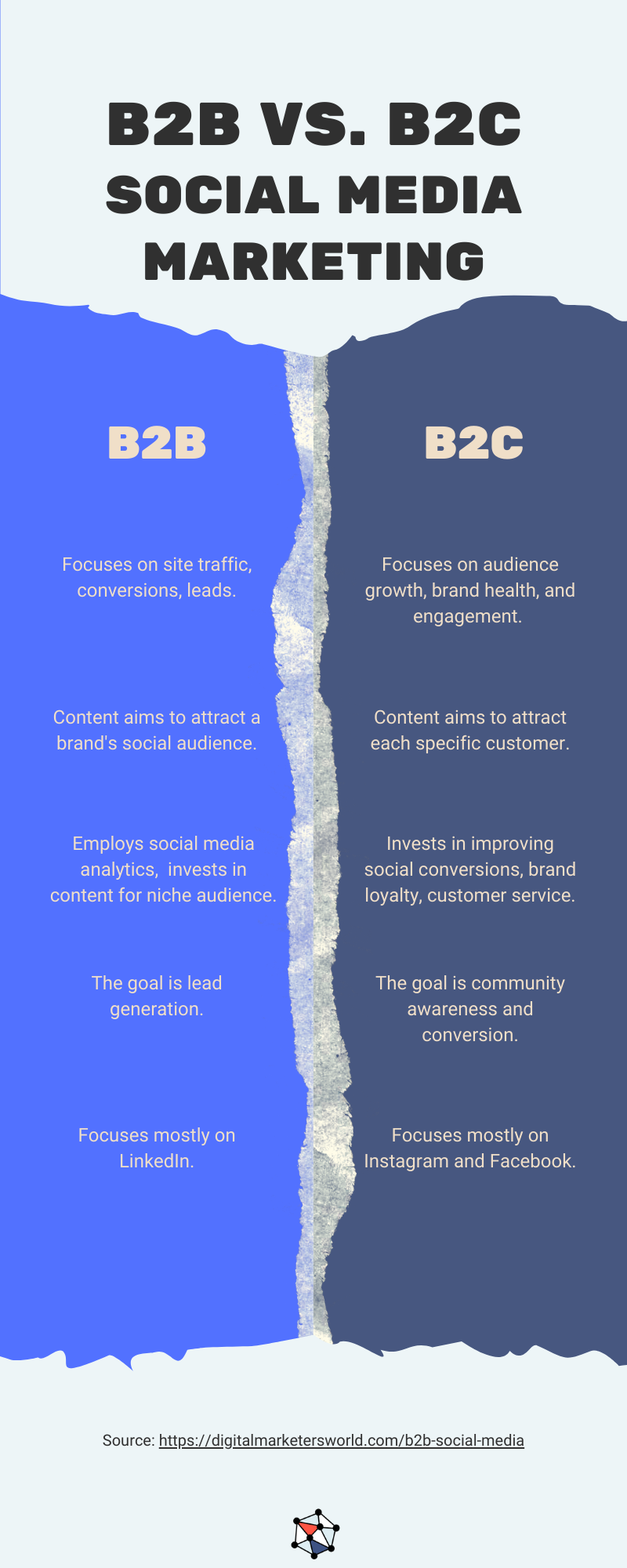
We’re going to start with the needs of the B2B customer base, which aims to find the right solution to a multi-faceted problem.
The needs of the customers
B2C customers have much simpler needs, typically knowing exactly what they’re looking to buy. On the other hand, B2B buyers typically have much more complex goals and needs, meaning they take longer to convert.
In fact, the B2B customer journey has become even longer in recent years. Here’s what the 2021 Buyer Preferences Study by Korn Ferry has shown:
- 60% of companies are giving additional scrutiny to buying items;
- Establishing relationships with vendors has become even more important – 65% of respondents said they closed a deal with existing vendors in only three months or less compared to only 36% with new vendors;
- Overall, 52% of participants confirmed that the sales cycle has extended.
So, to cover the ever more complex needs of B2B customers, social media marketing can greatly contribute to the Awareness and Consideration stages of the customer journey.
The motivation behind action
B2C customers are motivated by the product, while B2B customers are motivated by outcomes.
While a B2C customer will make most of their buying decisions based on emotion, B2B buyers will make their purchasing decisions in a more calculated, rational manner.
This is because B2B buyers typically need to go through several rounds of negotiations with potential partners and providers, often discussing the potential purchase between numerous key stakeholders.
What does this mean for your social media content?
You should make it more educational.
Start with the essential concepts of your business and educate your audience on every aspect of your brand and what it provides. This is the foundation of supporting a rational decision-making process when prospective B2B buyers are considering getting in touch with you.
Audience availability and brand focus
B2C companies can have a wide customer pool that can blur the brand’s focus and derail their social strategy if they’re not careful. B2B companies, on the other hand, are typically more specialized and serve a unique niche in a specific market.
Besides, B2B companies can have an easier time defining the key focus for their brands on social media. The key is to invest heavily in building relationships and educating their audience to build brand awareness and trust.
Now that you understand the top differences between B2C and B2B marketing on social media, let’s take a look at how to put together your social media marketing strategy.
5 Steps to Create an Effective B2B Social Media Strategy
A well-executed B2B social media strategy can help increase brand awareness, generate leads, and establish your company as a thought leader in your industry. But that’s just the tip of the iceberg, so here are the steps you need to take towards social media success:
Step #1: Align social media goals with business objectives
Your social media posts, campaigns, and efforts in general should all serve the purpose of supporting your brand’s short, mid, and long-term goals.
This will help ensure that your social media campaigns are focused on achieving specific, measurable results that are in line with the company’s mission and vision. It will also bridge the gap between social media teams and key decision-makers, as well as other mission-critical teams.
Here are some examples of social media goals and how you can connect them with your business objectives:
- Increase brand awareness ↣ build brand voice, authority and trust
- Drive traffic to your website ↣ use compelling messaging and link to your website pages and content
- Generate new leads ↣ use lead magnets, promotions and deals, and inspire people to provide some contact information
- Build a brand community ↣ contribute to worthy causes and weave your values into your posts and messaging
- Increase social sales ↣ engage people in the DMs and start creating interactive images and videos that allow them click on products and services they like
- Boost customer service ↣ train your experts to solve specific problems, answer complex questions and nurture long-standing customers
- Boost PR in your niche ↣ work with influencers, partner with reputable accounts and get tagged by industry experts in their posts
A great example of two goals overlapping is Semrush’s social media strategy.
To improve brand authority and trust in general, the company set the objective to use social media networks as a brand awareness booster. The idea is simple – share brand promotion posts with a twist:
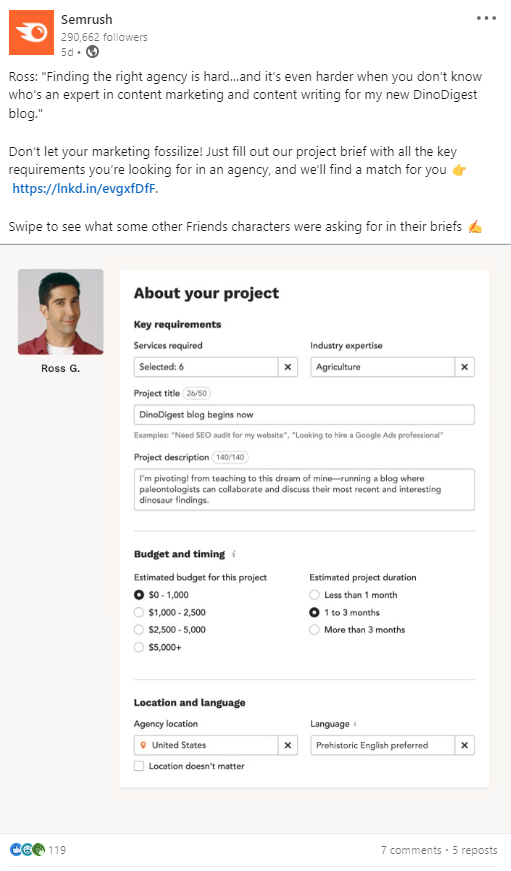
This post is a great example of how to make promotional posts not spammy using a popular pop culture phenomenon. But the intent is clear – posts like this create a unique content strategy, which makes Semrush more recognizable on social media networks.
Step #2: Identify the right channels
The second step is for B2B business owners to identify the right social media channels.
In the B2B sector, it might seem that LinkedIn is the top marketing channel all small businesses and large companies should use. But you don’t have to limit your strategy to Linkedin only..
In fact, Gartner voted Facebook to be the most popular network among B2B buyers (weirdly, LinkedIn is not even in the top three):
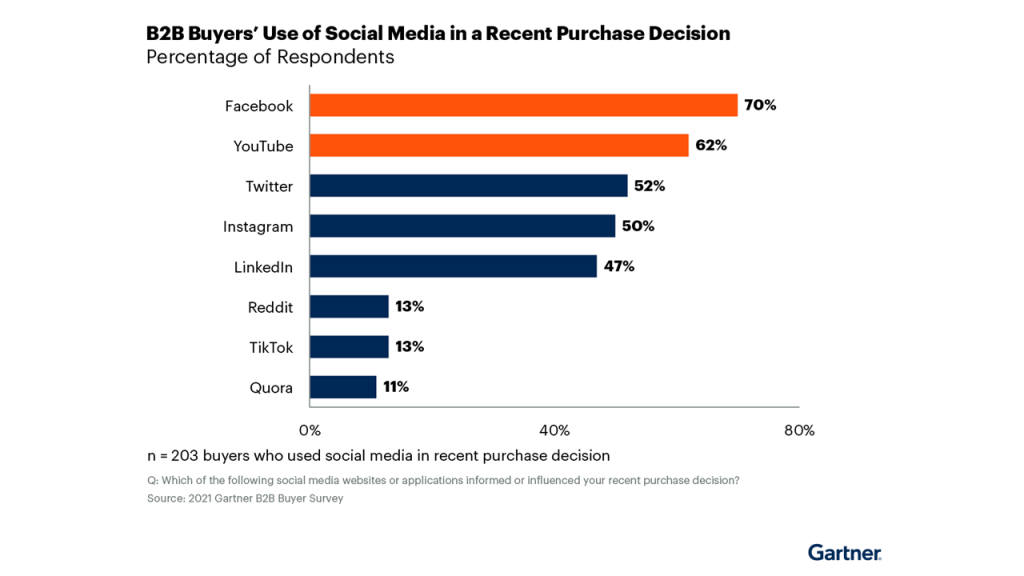
However, don’t just blindly trust these stats. Remember, they are general.
Indeed, when you’re looking to combine different digital marketing tactics, social media marketing and traditional marketing into an all-encompassing approach, these channels will help you build a powerful presence.
However, make sure to conduct thorough audience research to find out where your target audience is hanging out online. It’s also important to know when they’re most active and how they interact with their favorite B2B businesses.
It is also helpful to analyze your competitors and their social presence to get a clearer picture of the type of content that works best on your chosen channels.
Step #3: Create unique B2B content
Once you’ve identified the right channels, it’s time to create unique and relevant content for your target audience that also fits into your overarching content marketing strategy.
With B2B content creation, you should focus on educating your followers, providing solutions to specific problems, and establishing your company as a thought leader in your industry to build trust.
The great thing here is that you have plenty of opportunity to diversify your content offering and keep your posting schedule full of fresh content ideas. This is your opportunity to capitalize on event marketing to boost lead generation, build brand awareness and authority with quality content, and much more.
Content types can include:
- Blog posts
- Infographics
- GIFs
- Reel-type videos
- Long-form videos
- White papers
- Tutorials
- Pricing and price breakdowns
- Case studies
- Shout-outs and mentions
- Interviews
- Free resources such an eBook or a template
- Online events and announcements
- User-generated content
You can also use a combination of two or more of these content ideas. For instance, B2B brands on LinkedIn often use carousel posts which are a mix of infographics and some excerpts from blog posts, case studies, or interviews:
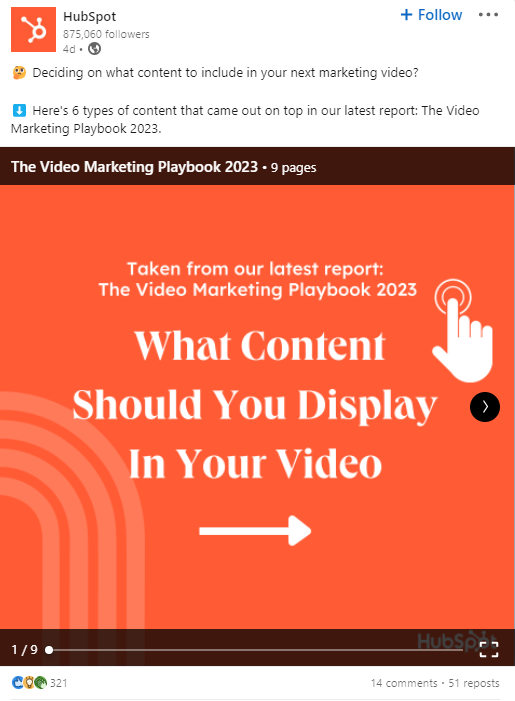
Make sure to use complementary hashtags with all your content on every platform.
Step #4: Repurpose your content
To maximize the value of your content, you can repurpose it across multiple channels and formats.
For instance, you can turn a blog post into an infographic or a video, or you can use social media to promote a case study on a landing page. This will help you reach a wider audience and maximize the impact of your content.
Here’s an example of Digital Olympus repurposing its blog post into a downloadable checklist:
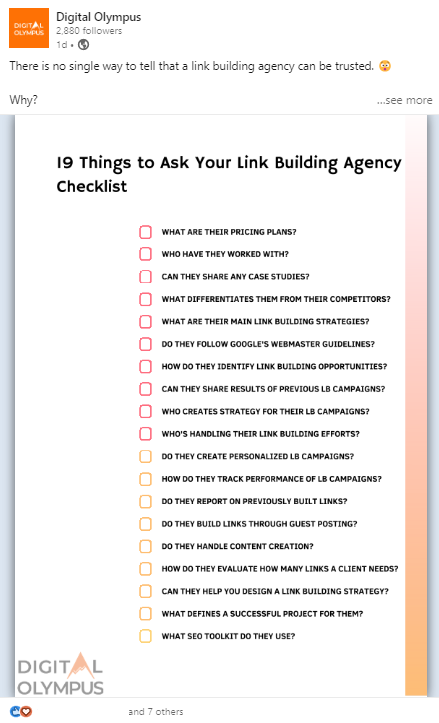
The main opportunity here is to repurpose your best content for different social media channels, however.
Do you have a top-ranking article on your website full of useful information?
Create an infographic for LinkedIn with the key takeaways and then link to the original piece.
Have a long-form educational video?
Cut it up into bite-size pieces and make it into a dedicated series of reels and Instagram stories or TikTok educational clips to drive engagement and inspire the followers to keep coming back to your page.
The list of ideas can be endless.
Step #5: Track results
The final step in creating an effective B2B social media strategy is to track and measure your results. By using dedicated social media analytics tools, you can track key metrics such as:
- Website traffic
- Reach per platform
- Follower count/audience growth rate
- Engagement
- Conversion rate and click-through rate
- Impressions
This will help you understand what’s working, what’s not, and make informed decisions about future social media activities. Needless to say, this data will also fuel your B2B email marketing strategy, your content strategy, and other social activities such as working with influencers, and more.
Tip: social media management tools will give you a general overview of how your social media accounts are performing:
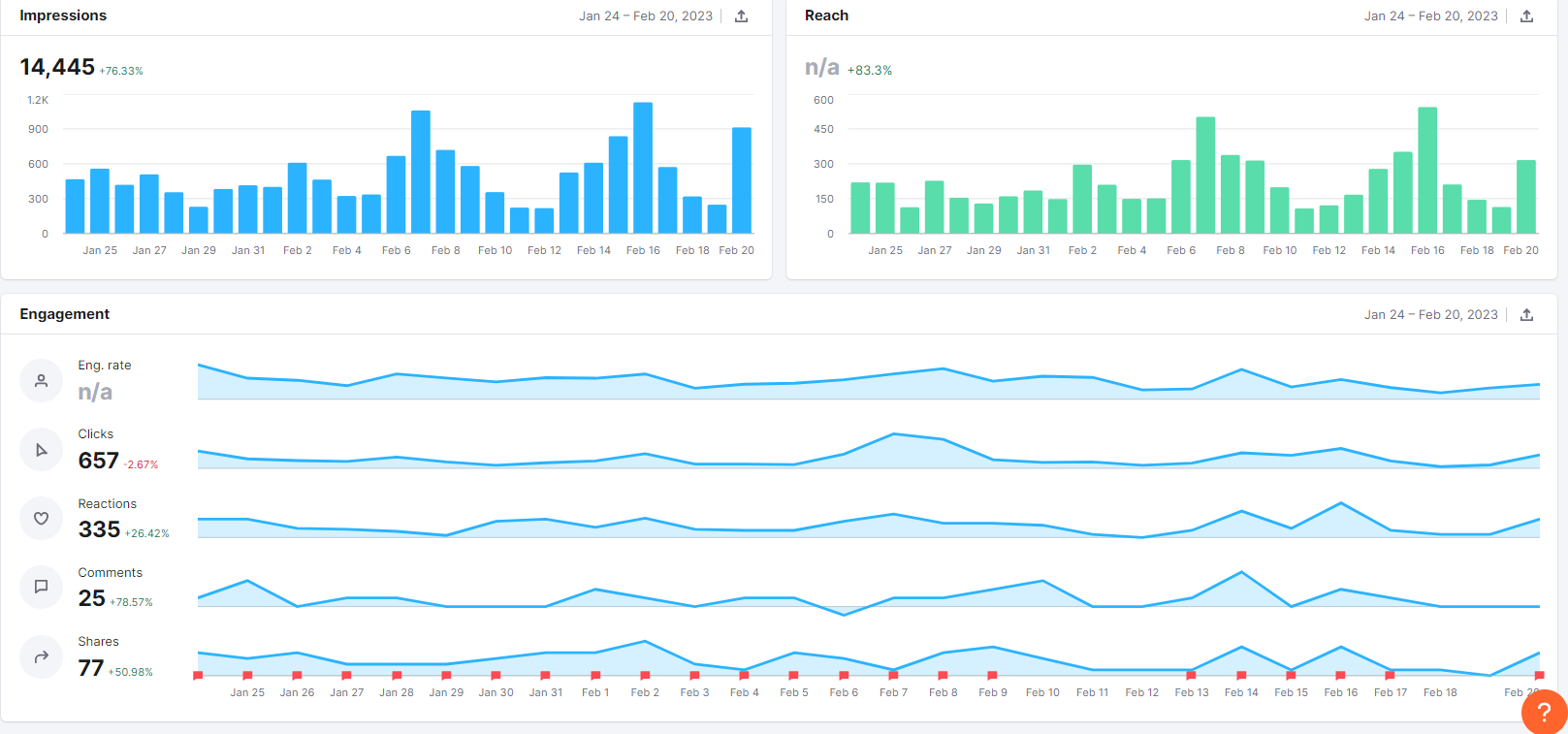
However, this data isn’t always accurate, so it’s always a smart idea to check built-in social media tools, especially for the metrics like impressions, reach, and engagement.
Finally, let’s take a look at the best social media platforms for B2B brands.
What are the Best Social Media Platforms for B2B Companies?
If you remember Gartner’s graph from above, you also recall that Facebook was voted the top social media platform among B2B buyers.
However, you will find that most B2B companies are actually more active on LinkedIn and Twitter, and Facebook only comes fourth on our list.
Let’s take a look at these and other channels popular among B2B and SaaS brands.
With over 900 million members worldwide, LinkedIn is among the most popular social media platforms for B2B companies. It’s designed specifically for professionals and businesses, making it the best channel for establishing thought leadership, building relationships, and generating leads.
LinkedIn is also a great place to share content, participate in industry discussions, and connect with potential customers.
The type of content you want to focus on here includes:
- High-level advice and insights for B2B business owners and CEOs
- Educating your following on your core products and services
- Mentioning and talking about important events and developments in your space
Twitter is a fast-paced and dynamic platform that allows B2B companies to share real-time updates, participate in industry discussions, and engage with their target audience. It is particularly effective for B2B companies that want to reach a wide and diverse audience, as well as engage in real-time conversations.
It’s so powerful, in fact, that over 54% of B2B businesses now use Twitter as an integral part of their social media marketing strategy.
While Instagram is typically associated with B2C companies, it can also be a valuable channel for B2B companies. Instagram is a visually-driven platform that allows B2B companies to showcase their products, services, and company culture.
In other words, this is your opportunity to build a positive brand image and identity.
Instagram is particularly effective for B2B companies that sell visually appealing products or services, but with over one billion users, it’s safe to say that all B2B brands have something to gain here.
Facebook is the largest social media platform in the world, with over 2.9 billion users. While it’s primarily associated with B2C companies, stats from Gartner show that it can also be a valuable platform for B2B companies.
Facebook is a great channel for building brand awareness, connecting with customers, and sharing content. It’s also a great platform for B2B companies to showcase their products, services, and company culture, leaning more towards long-form content unlike Instagram.
Complemented with Facebook Ads, you can maximize your targeting and reach a wide audience across the world.
YouTube
YouTube is a powerful media outlet that allows B2B companies to showcase their products and services in great detail. This platform is perfect if you want to demonstrate your expertise, educate your audience, even run a podcast, and simply build a devoted community.
It’s interesting to note that 67% of marketers plan to increase their YouTube video marketing in the next 12 months, so this is an excellent opportunity for you to communicate valuable information, educate your audience, and build a powerful brand.
Now Over to You
Investing in social media marketing should be a top priority for all growth-oriented B2B companies in 2023. With these tips and insights in mind, go ahead and kick-start your social media journey that will see you grow your following, build a powerful brand presence, and achieve your business goals.
Interested in more articles on B2B social media marketing?
Subscribe to our blog to stay updated on all new content pieces!

Nick Sekulic is a seasoned brand developer, a writer, and a storyteller, having worked on various marketing, branding and copywriting projects – crafting plans and strategies, writing creative online and offline content, and making ideas happen.
